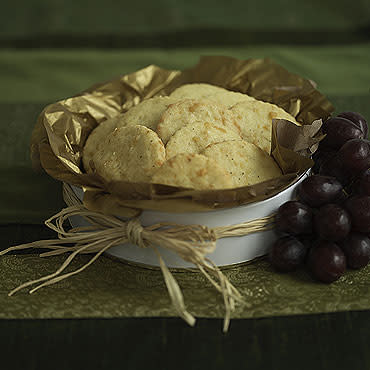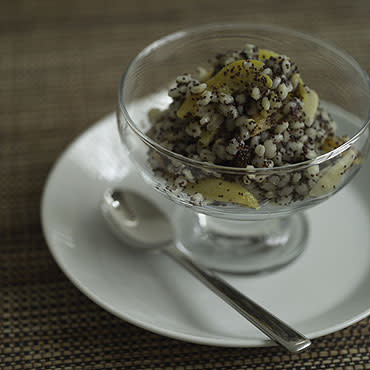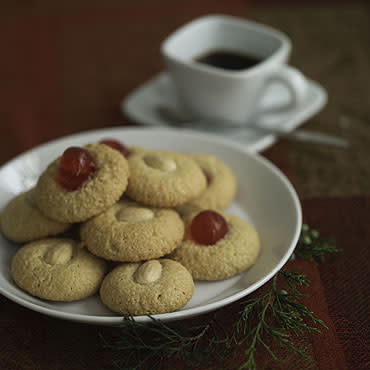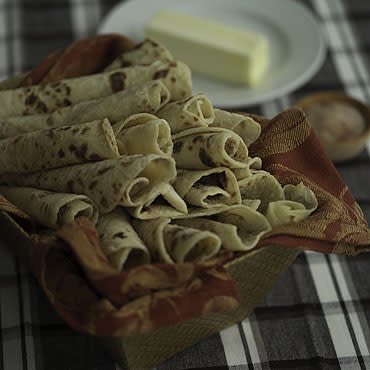Global goodies-Five Christmas treats from around the world
Stuck in a holiday baking rut? Go global. Christmas is celebrated by one-third of the world's population, and they don't all eat gingerbread and fruitcake. To help you perk up your standard spread, we've tasted our way through an incredible array of international treats and collected our favorites below, along with tidbits on how the holiday is observed in each country. Try one of these fun traditions at your celebration this year, and maybe add a recipe or two to your repertoire: Ukrainian kutia pudding would enliven a Christmas Eve dinner, Chilean pan de pasqua would be delicious for Christmas brunch, and Santa might appreciate some Italian amaretti alongside the usual sugar cookies. Feliz Navidad, Gledelig Jul, and Srozhdestvom Kristovym!
Christmas Recipes and Traditions
Chile: Pan de Pasqua (Christmas Bread)
In Chile , celebrations get going on Christmas Eve. A midnight mass, called Misa de Gallo or "Mass of the Rooster," marks the beginning of the new day and the birth of Christ. (Those who miss it must wait until late afternoon on Christmas Day for the next service, since the clergy, like everyone else, sleeps in.) After Mass, celebrants feast on a meal of roast turkey or beef and vegetables. Gifts are exchanged, and children often spill out into the streets, enjoying the warm summer air of the Southern Hemisphere and showing off their new toys to friends before finally going to bed.
Bread is an integral part of every Chilean meal, and at Christmas, it's pan de pasqua, a round, eggy loaf similar to Italian panettone and German stollen. Flavored with brandy and dotted with candied fruit, pan de pasqua is served with the Christmas Eve meal and again on Christmas Day, when friends and family visit one another and enjoy leftovers, sweets, and a creamy drink similar to eggnog.
See the recipe for Pan de Pasqua here.
Italy: Amaretti (Almond Cookies)
Introduced to southern Italy in ancient times through trade with the Middle East , almonds quickly became popular in the country's cooking, even spreading to northern towns such as Saronno. Famous for its liqueur Amaretto di Saronno, the town is also known for amaretti, crunchy cookies made primarily from ground almonds, egg whites, and sugar. Bakeries throughout Italy (and, indeed, in the U.S. ) carry these treats at Christmastime, but they're even better when made fresh at home.
See the recipe for Amaretti here.
Norway: Lefse (Flatbreads)
In Norwegian folklore, an interesting character exists: the nisse, or gnome. Over time, this figure has merged with the imported concept of Santa Claus, resulting in several versions of Santa in Norwegian Christmas festivities. The Fjøsnisse, or barn gnome, is a mischevious spirit for whom families traditionally leave a bowl of porridge on Christmas Eve, in hopes that he will ensure a prosperous year. The Julenisse is a friendlier fellow who brings gifts to children.
Baking is a huge part of Christmas in Norway . Cooks prepare numerous types of cookies such as gingersnaps, along with a spiced cake called julekake. On Christmas Eve, families gather around an evergreen decorated with lights or candles, sing carols, dine on roast pork, and exchange presents. Another popular treat are lefse, flatbreads made from potato dough. Enjoyed year-round, but especially on holidays, lefse can be spread with butter and sprinkled with cinnamon sugar, or wrapped around savory foods such as fish or meat.
Scotland: Sharp-Cheddar Shortbreads
In Scotland , Christmas means traditions that go back to pre-Christian times. In midwinter, the ancient Scots celebrated a fire festival in honor of the slowly lengthening days and the return of spring. A remnant of this time is the Yule log, a piece of birch that is ceremonially stripped of bark and brought in by the men of the house on Christmas Eve. Once the log is lit, the fire burns all night, and in the morning the charred remains are placed under the bed of the lady of the house for protection against fire for the coming year.
Christmas Eve fare traditionally consists of dried-fruit "mincemeat" pies, oatmeal bread, and wassail, a hot drink made from ale, roasted apples, eggs, sugar, spices, and, in some areas, Scotch. Christmas day is usually quiet, spent visiting family and attending church services. Christmas dinner typically features roast beef, goose, venison, salmon, chicken, pheasant, or even boar, plus sometimes " ----- -a-leekie" soup and plum pudding.
Another tradition possibly stemming from the ancient fire festival is shortbread, originally baked in a round shape that may have symbolized the sun. Early recipes for shortbread contained butter and ground oats or nuts, but now it's typically made from refined wheat flour, served with afternoon tea, and eaten all year round, but especially on Christmas and New Year's. Our version is slightly unorthodox, incorporating sharp Cheddar (also a native Scottish ingredient) for a savory twist.
See a recipe for Sharp-Cheddar Shortbread here.
Ukraine: Kutia (Grain Pudding)
Based in Eastern Europe , Greece , and Russia , the Orthodox Christian church differs in many ways from the Western (Latin) one. But it's the Orthodox church that gave the Christian world one of its most beloved figures: St. Nicholas.
It's believed that the real St. Nicholas was born in Lycia , in present-day Turkey , in the fourth century A.D. He rose to the position of bishop of the Lycian city of Myra , and founded a poorhouse, hostelries, and a hospital. His charity earned him a reputation as the personification of Christian love and affection, and after his death, he became one of the church's most popular saints, honored with a feast day on December 6. In many countries his legend mixed with local traditions, and he became a giver of gifts and patron saint of children. Eventually, he was associated with Christmas. In the Netherlands , his name was contracted to Sinterklaas which, when it traveled to the U.S. with Dutch immigrants, became Santa Claus.
Christmas in the Ukraine is celebrated on January 7, because the country uses the old Gregorian, rather than the Julian, calendar. On Christmas Eve, families sit down to a meal called the Sviata Vechera, or Holy Supper, which consists of 12 symbolic dishes. The first of these is a pudding called kutia, made from grain, which symbolizes fertility and abundance; poppy seeds, which represent peace; and honey, which stands for the sweet spirit of Christ. Our version of this delightfully chewy dish uses barley and adds dried apricots, sliced almonds, and raisins.
By Tracey Seaman
MORE FROM EPICURIOUS.COM
Food News and Views From All Over
Mario Batali's Feast of the Seven Fishes
The Chef Demonstrates Recipes for a Traditional Italian Christmas Eve Dinner
Delicious, Top-Rated Holiday Cookies That Are Perfect to Give-And Get
Gourmet Baskets, Boxes, and Buckets for Under $100
Video Special: Molecular Mixology Defined and Demonstrated
Bartender Eben Freeman Explains the Fundamentals of Progressive Cocktails in Five Videos





